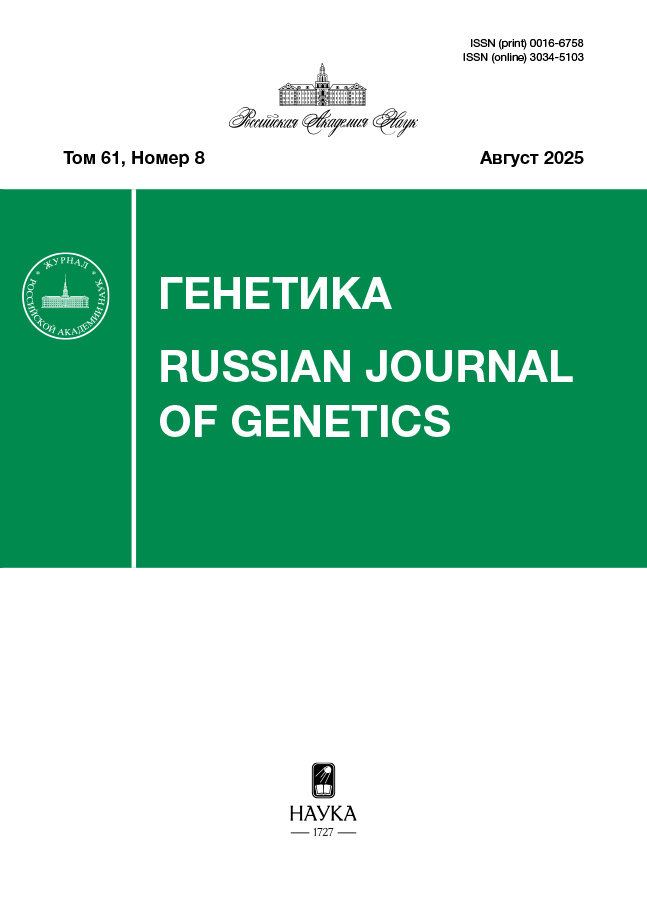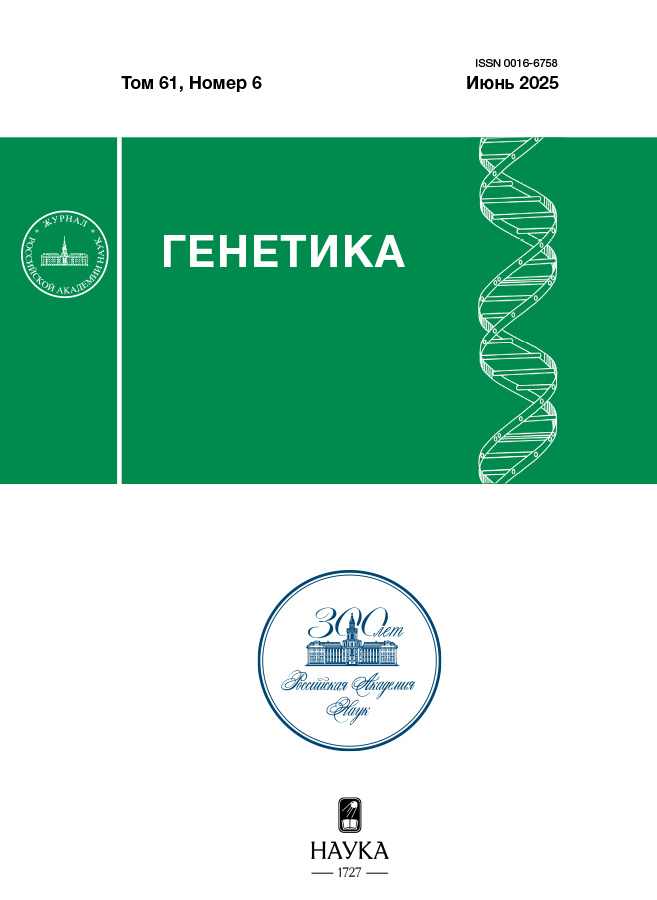Характеристика конверсии корма по половым хромосомам методом полногеномного ассоциативного исследования
- Авторы: Белоус А.А.1, Отраднов П.И.1, Сермягин А.А.1, Зиновьева Н.А.1
-
Учреждения:
- Федеральный исследовательский центр животноводства – ВИЖ имени академика Л.К. Эрнста
- Выпуск: Том 61, № 6 (2025)
- Страницы: 58-69
- Раздел: ГЕНЕТИКА ЖИВОТНЫХ
- URL: https://journals.eco-vector.com/0016-6758/article/view/686989
- DOI: https://doi.org/10.31857/S0016675825060051
- EDN: https://elibrary.ru/SWHFBH
- ID: 686989
Цитировать
Полный текст
Аннотация
Изучение количественных и качественных признаков с точки зрения генетической направленности невозможно без учета болезней или особенностей, сцепленных с полом. В настоящее время геномная селекция по половым хромосомам, проведенная методом полногеномного ассоциативного исследования, не была ключевым фактором для разработки специального кода и функциональной аннотации генов с учетом библиотек GO, KEGG и анализа ранее выявленных генов. Целью научно-практического исследования было создание программного кода для проведения GWAS по половым хромосомам свиней и поиск функционально значимых генов для объяснения связи «фенотип – генетика пола», которая в дальнейшем конкретизирует селекционный отбор свиней в нуклеус популяции и позволит заранее прогнозировать наследственные заболевания животных. В данной статье мы впервые провели GWA-анализ геномных оценок племенной ценности признака конверсии корма с учетом только половых хромосом (sGWAS). Структурная аннотация выявила 21 ген, расположенный на Х-хромосоме, и восемь генов – на Y-хромосоме, включая гомологичный участок XY. Проведенный кластерный анализ полученных генов обнаружил значимую взаимосвязь с коэффициентом конверсии корма у восьми из них: STS, DDX3X, PUDP, PNPLA4, DHRSX, GPR143, SHROOM2 и PRKX. Функциональная аннотация данных генов выявила их значительный вклад в биологические процессы организма, включая наследственные заболевания и специфичность сцепленных с полом.
Полный текст
Об авторах
А. А. Белоус
Федеральный исследовательский центр животноводства – ВИЖ имени академика Л.К. Эрнста
Автор, ответственный за переписку.
Email: belousa663@gmail.com
Россия, 142132, Московская область, пос. Дубровицы
П. И. Отраднов
Федеральный исследовательский центр животноводства – ВИЖ имени академика Л.К. Эрнста
Email: belousa663@gmail.com
Россия, 142132, Московская область, пос. Дубровицы
А. А. Сермягин
Федеральный исследовательский центр животноводства – ВИЖ имени академика Л.К. Эрнста
Email: belousa663@gmail.com
Россия, 142132, Московская область, пос. Дубровицы
Н. А. Зиновьева
Федеральный исследовательский центр животноводства – ВИЖ имени академика Л.К. Эрнста
Email: belousa663@gmail.com
Россия, 142132, Московская область, пос. Дубровицы
Список литературы
- Указ Президента РФ от 28.02.2024 № 145 «О Стратегии научно-технологического развития Российской Федерации».
- Gustavsson I. Standard karyotype of the domestic pig. Committee for the Standardized Karyotype of the Domestic Pig // Hereditas. 1988. V. 109. P. 151–157. https://doi.org/10.1111/j.1601-5223.1988.tb00351.x
- Adega F., Chaves R., Guedes-Pinto H. Chromosome restriction enzyme digestion in domestic pig (Sus scrofa) Constitutive heterochromatin arrangement // Genes Genet. Syst. 2005. V. 80. P. 49–56. https://doi.org/10.1266/ggs.80.49
- Hansen K.M. Sequential Q- and C-band staining of pig chromosomes, and some comments on C-band polymorphism and C-band technique // Hereditas. 1982. V. 96. P. 183–189. https://doi.org/10.1111/j.1601-5223.1982.tb00848.x
- Quilter C.R., Blott S.C., Mileham A.J. et al. A mapping and evolutionary study of porcine sex chromosome gene // Mamm. Genome. 2002. V. 13. P. 588–594. https://doi.org/10.1007/s00335-002-3026-1
- Cornefert-Jensen F., Hare W.C., Abt D.A. Identification of the sex chromosomes of the domestic pig // J. Hered. 1968. V. 59. P. 251–255. https://doi.org/10.1093/oxfordjournals.jhered.a107710
- Grunwald D., Geffrotin C., Chardon P. et al. Swine chromosomes: flow sorting and spot blot hybridization // Cytometry. 1986. V. 7. P. 582–588. https://doi.org/10.1002/cyto.990070613
- Thomsen P.D., Hindkjaer J., Christensen K. Assignment of a porcine male-specific DNA repeat to Y-chromosomal heterochromatin // Cytogenet. Cell Genet. 1992. V. 61. P. 152–154. https://doi.org/10.1159/000133395
- Alfoldi J., Skaletsky H., Graves T. et al. Sequence of the mouse Y Chromosome. Seattle: USA, 2004.
- Alföldi J.E. Sequence of the mouse Y chromosome: PhD Thesis. Massachusetts: Massachusetts Inst. Technol., Department of Biol., 2008.
- Hamilton C.K., Revay T., Domander R. et al. A large expansion of the HSFY gene family in cattle shows dispersion across Yq and Testis-Specific Expression // PLoS One. 2011. V. 6 (3). https://doi.org/10.1371/journal.pone.0017790
- Horng Y.-M., Huang M.-C. Male-specific DNA sequences in pigs // Theriogenology. 2003. V. 59. P. 841–848. https://doi.org/10.1016/S0093-691X(02)01150-0
- Pérez-Pérez J., Barragán C. Isolation of four pig male-specific DNA fragments by RDA // Anim. Genet. 1998. V. 29. P. 157–158.
- Skinner B.M., Lachani K., Sargent C.A., Affara N.A. Regions of XY homology in the pig X chromosome and the boundary of the pseudoautosomal region // BMC Genet. 2013. V. 14 (3). https://doi.org/10.1186/1471-2156-14-3
- Park J., Cho Y.G., Kim J.K., Kim H.H. STS and PUDP deletion identified by targeted panel sequencing with CNV analysis in X-linked ichthyosis // Genes (Basel). 2023. V. 14. (10). https://doi.org/10.3390/genes14101925
- Moghaddam S., Houshangi A.F., Eshratkhah B., Allahvirdizadeh R. Clinical report of a Holstein's calf with ichthyosis // Vet. Res. Forum. 2021. V. 12. № 1. P. 133–135. https://doi.org/10.30466/vrf.2020.117113.2783
- Câmara A.C.L., Borges P.A.C., Paiva S.A., Pierezan F. Ichthyosis fetalis in a cross-bred lamb // Vet. Dermatol. 2017. V. 28. P. 516–525. https://doi.org/10.1111/vde.12459
- Belknap E.B., Dunstan R.W. Congenital ichthyosis in a llama // J. Am. Vet. Med. Assoc. 1990. V. 197(6). P. 764–767.
- Holmes R.S. Vertebrate patatin-like phospholipase domain-containing protein 4 (PNPLA4) genes and proteins: A gene with a role in retinol metabolism // 3 Biotech. 2012. V. 2. P. 277–286. https://doi.org/10.1007/s13205-012-0063-7
- Gray K.A., Yates B., Seal R.L. et al. Genenames.org: the HGNC resources in 2015 // Nucl. Acids Res. 2015. V. 43(D1). P. D1079–D1085. https://doi.org/10.1093/nar/gku1071
- Dodé C., Hardelin J.P. Kallmann syndrome // Eur. J. Hum. Genet. 2009. V. 17(2). P. 139–146. https://doi.org/10.1038/ejhg.2008.206
- MacColl G., Bouloux P., Quinton R. Kallmann syndrome: adhesion, afferents, and anosmia // Neuron. 2002. V. 34. № 5. P. 675–678. https://doi.org/10.1016/s0896-6273(02)00720-1
- Prakash S.K., Paylor R., Jenna S. et al. Functional analysis of ARHGAP6, a novel GTPase-activating protein for RhoA // Hum. Mol. Genet. 2000. V. 9(4). P. 477–488. https://doi.org/10.1093/hmg/9.4.477
- Brunet T., McWalter K., Mayerhanser K. et al. Defining the genotypic and phenotypic spectrum of X-linked MSL3-related disorder // Genet. Med. 2021. V. 23(2). P. 384–395. https://doi.org/10.1038/s41436-020-00993-y
- Deciphering Developmental Disorders Study. Prevalence and architecture of de novo mutations in developmental disorders // Nature. 2017. V. 542. P. 433–438. https://doi.org/10.1038/nature21062
- Lucas C.G., Spate A.M., Samuel M.S. et al. A novel swine sex-linked marker and its application across different mammalian species // Transgenic Res. 2020. V. 29. P. 395–407. https://doi.org/10.1007/s11248-020-00204-z
- O'Connor E., Eisenhaber B., Dalley J. et al. Species specific membrane anchoring of nyctalopin, a small leucine-rich repeat protein // Human Mol. Genet. 2005. V. 14(13). P. 1877–1887. https://doi.org/10.1093/hmg/ddi194
- Huang T.N., Hsueh Y.P. CASK point mutation regulates protein-protein interactions and NR2b promoter activity // Biochem. Biophys. Res Commun. 2009. V. 382(1). P. 219–222. https://doi.org/10.1016/j.bbrc.2009.03.015
- Najm J., Horn D., Wimplinger I. et al. Mutations of CASK cause an X-linked brain malformation phenotype with microcephaly and hypoplasia of the brainstem and cerebellum // Nat. Genet. 2008. V. 40. P. 1065–1067. https://doi.org/10.1038/ng.194
- Atasoy D., Schoch S., Ho A. et al. Deletion of CASK in mice is lethal and impairs synaptic function // Proc. Natl Acad. Sci. USA. 2007. V. 104(7). P. 2525–2530. https://doi.org/10.1073/pnas.0611003104
- Engemaier E., Römpler H., Schöneberg T., Schulz A. Genomic and supragenomic structure of the nucleotide-like G-protein-coupled receptor GPR34 // Genomics. 2006. V. 87(2). P. 254–264. https://doi.org/10.1016/j.ygeno.2005.10.001
- Engel K.M., Schröck K., Teupser D. et al. Reduced food intake and body weight in mice deficient for the G protein-coupled receptor GPR82 // PLoS One. 2011. V. 6(12). https://doi.org/10.1371/journal.pone.0029400
- Sallmann G.B., Bray P.J., Rogers S. et al. Scanning the ocular albinism 1 (OA1) gene for polymorphisms in congenital nystagmus by DHPLC // Ophthalmic Genet. 2006. V. 27. P. 43–49. https://doi.org/10.1080/13816810600677834
- Jia X., Yuan J., Jia X. et al. GPR143 mutations in Chinese patients with ocular albinism type 1 // Mol. Med. Rep. 2017. V. 15(5). P. 3069–3075. https://doi.org/10.3892/mmr.2017.6366
- Clapier C.R., Iwasa J., Cairns B.R., Peterson C.L. Mechanisms of action and regulation of ATP-dependent chromatin-remodelling complexes // Nat. Rev. Mol. Cell. Biol. 2017. V. 18(7). P. 407–422. https://doi.org/10.1038/nrm.2017.26
- Picketts D., Mirzaa G., Yan K. et al. Pathogenic variants in SMARCA1 cause an X-linked neurodevelopmental disorder modulated by NURF complex composition // Res. Sq. [Preprint]. 2023. https://doi.org/10.21203/rs.3.rs-3317938/v1
- Festa B.P., Berquez M., Gassama A. et al. OCRL deficiency impairs endolysosomal function in a humanized mouse model for Lowe syndrome and Dent disease // Hum. Mol. Genet. 2019. V. 28(12). P. 1931–1946. https://doi.org/10.1093/hmg/ddy449
- Gianesello L., Arroyo J., Del Prete D. et al. Genotype phenotype correlation in dent disease 2 and review of the literature: OCRL gene pleiotropism or extreme phenotypic variability of Lowe syndrome? // Genes (Basel). 2021. V. 12(10). https://doi.org/10.3390/genes12101597
- Tatemoto K., Hosoya M., Habata Y. et al. Isolation and characterization of a novel endogenous peptide ligand for the human APJ receptor // Biochem. Biophys. Res. Commun. 1998. V. 251 (2). P. 471–476. https://doi.org/10.1006/bbrc.1998.9489
- Tatemoto K., Takayama K., Zou M.X. et al. The novel peptide apelin lowers blood pressure via a nitric oxide-dependent mechanism // Regul. Pept. 2001. V. 99(2–3). P. 87–92. https://doi.org/10.1016/s0167-0115(01)00236-1
- Hu G., Wang Z., Zhang R. et al. The role of apelin/apelin receptor in energy metabolism and water homeostasis: A comprehensive narrative review // Front. in Physiology. 2021. V. 12. https://doi.org/10.3389/fphys.2021.632886
- Sörhede Winzell M., Magnusson C., Ahrén B. The apj receptor is expressed in pancreatic islets and its ligand, apelin, inhibits insulin secretion in mice // Regul. Pept. 2005. V. 131(1–3). P. 12–17. https://doi.org/10.1016/j.regpep.2005.05.004
- Dray C., Knauf C., Daviaud D. et al. Apelin stimulates glucose utilization in normal and obese insulin-resistant mice // Cell. Metab. 2008. V. 8(5). P. 437–445. https://doi.org/10.1016/j.cmet.2008.10.003
- Kawamata Y., Habata Y., Fukusumi S. et al. Molecular properties of apelin: tissue distribution and receptor binding // Biochim. Biophys. Acta. 2001. V. 1538(2–3). P. 162–171. https://doi.org/10.1016/s0167-4889(00)00143-9
- Mercati F., Scocco P., Maranesi M. et al. Apelin system detection in the reproductive apparatus of ewes grazing on semi-natural pasture // Theriogenology. 2019. V. 139. P. 156–166. https://doi.org/10.1016/j.theriogenology.2019.08.012
- Rak A., Drwal E., Rame C. et al. Expression of apelin and apelin receptor (APJ) in porcine ovarian follicles and in vitro effect of apelin on steroidogenesis and proliferation through APJ activation and different signaling pathways // Theriogenology. 2017. V. 96. P. 126–135. https://doi.org/10.1016/j.theriogenology.2017.04.014
- Wang X., Liu X., Song Z. et al. Emerging roles of APLN and APELA in the physiology and pathology of the female reproductive system // PeerJ. 2020. V. 8. e10245. https://doi.org/10.7717/peerj.10245
- Dobrzyn K., Kiezun M., Kopij G. et al. Apelin-13 modulates the endometrial transcriptome of the domestic pig during implantation // BMC Genomics. 2024. V. 25(501). https://doi.org/10.1186/s12864-024-10417-9
- Duan Q.L., Nikpoor B., Dube M.P. et al. A variant in XPNPEP2 is associated with angioedema induced by angiotensin I-converting enzyme inhibitors // Am. J. Hum. Genet. 2005. V. 77(4). P. 617–626. https://doi.org/10.1086/496899
- Delmonte O.M., Bergerson J.R.E., Kawai T. et al. SASH3 variants cause a novel form of X-linked combined immunodeficiency with immune dysregulation // Blood. 2021. V. 138(12). P. 1019–1033. https://doi.org/10.1182/blood.2020008629
- Maak S., Boettcher D., Tetens J. et al. Expression of microRNAs is not related to increased expression of ZDHHC9 in hind leg muscles of splay leg piglets // Mol. Cell. Probes. 2010. V. 24(1). P. 32–37. https://doi.org/ 10.1016/j.mcp.2009.09.001
- Paganini L., Hadi L.A., Chetta M. et al. A HS6ST2 gene variant associated with X-linked intellectual disability and severe myopia in two male twins // Clin. Genet. 2019. V. 95(3). P. 368–374. https://doi.org/10.1111/cge.13485
- Li Q.Y., Zhang Y.C., Wei C. et al. The association between mutations in ubiquitin-specific protease 26 (USP26) and male infertility: A systematic review and meta-analysis // Asian. J. Androl. 2022. V. 24(4). P. 422–429. https://doi.org/10.4103/aja2021109
- Skinner B.M., Lachani K., Sargent C.A., Affara N.A. Regions of XY homology in the pig X chromosome and the boundary of the pseudoautosomal region // BMC Genet. 2013. V. 14. https://doi.org/10.1186/1471-2156-14-3
- Zhang G., Luo Y., Li G. et al. DHRSX, a novel non-classical secretory protein associated with starvation induced autophagy // Int. J. Med. Sci. 2014. V. 11(9). P. 962–970. https://doi.org/10.7150/ijms.9529
Дополнительные файлы













